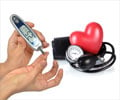A systematic review to assess the efficacy of mind-body therapies (MBT), such as meditation, yoga and guided imagery in the treatment of hypertension.
A systematic review to assess the efficacy of mind-body therapies (MBT), such as meditation, yoga and guided imagery in the treatment of hypertension, has shown that such complementary and alternative medicine (CAM) approaches significantly reduce systolic and diastolic blood pressures.
The review and synthesis of 12 published randomised trials also showed that yoga was the most effective among the three therapies studied in reducing hypertension.The researchers involved in the study reviewed randomised, or quasi-randomised, controlled trials comparing mind-body techniques (meditation, yoga, and guided imagery) alone or in combination with conventional treatment to conventional treatment alone or no intervention/waiting list control.
Participants in these trials were adult men and non-pregnant women who were suffering from hypertension, defined as a systolic blood pressure of 140 mm Hg and/or diastolic blood pressure 90 mm Hg.
Relevant trials were identified in the register of trials maintained by the Cochrane Complementary Medicine Field Registry, The Cochrane Central Register of Controlled Trials, Medline, EMBASE, PsycInfo, and CINAHL.
It was found that mind-body therapies significantly reduced systolic blood pressure (SBP) by a mean 11.52 mm Hg and diastolic blood pressure (DBP) by 6.83 mm Hg.
The study also showed that yoga therapies demonstrated results of the greatest magnitude, with mean SBP reductions of 19.07 mm Hg and DBP by 13.13 mm Hg. Significant results were seen in SBP reductions by yoga and meditation therapy, while only yoga therapies demonstrated significant reductions in DBP.
Advertisement
"This review shows that there is some high quality scientific literature supporting the use of mind-body therapies as a treatment for hypertension, and the magnitude of effect is clinically significant," says lead author of the study, Dr. Ather Ali of the Prevention Research Center, School of Medicine, Yale University.
Source-ANI
SRM/J











